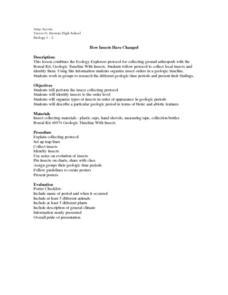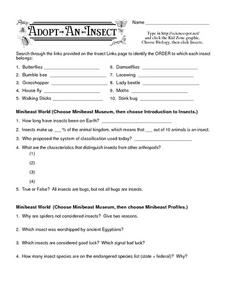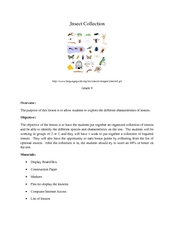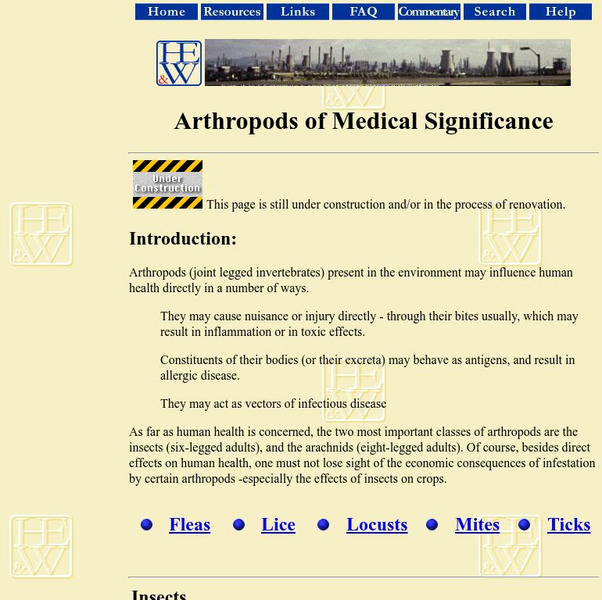Scholastic
Study Jams! Arthropods
No need to be crabby! Here is a resource that teaches your class about the characteristics of arthropods and provides stunning photos of several of them. In addition to the superb slides and their informative accompanying captions, the...
Curated OER
Unidentified (Flying?) Arthropods
Beginning biologists learn the characteristics of the five classes in the arthropod phylum. A student handout lists characteristics to help them identify five specimens. You will need to collect an example of each: arachnida, crustacea,...
Curated OER
Arthropods
A set of note-taking slides introduces your biologists to the characteristics and the four subphyla of arthropods. Nothing flashy is included, but it is a tidy and straightforward presentation that you can use when your class is studying...
Curated OER
Exploration of "Pillbugs"
Fifth graders define vocabulary terms, identify the characteristics of a pillbug, and create a dichotomous key. Then they examine the pillbugs and make observations and record these observations. Finally, 5th graders observe specific...
Curated OER
Tarantulas!
Pupils research on the internet and study about the mysterious eight-legged arthropod, tarantulas. They apply what they've discovered to create a three-dimensional tarantula model with an imaginary, colorful and descriptive name given to...
Curated OER
How Insects Have Changed
Students work in groups to research the different geologic time periods and present their findings. They perform the insect collecting protocol, identify insects to the order level, and organize types of insects in order of appearance in...
Curated OER
Invertebrates
For this invertebrate worksheet, students review characteristics of the different types of invertebrates. This worksheet places 32 vocabulary words into a crossword puzzle.
Curated OER
Digging Into Science Lesson Plans
In this biology worksheet, students identify and write the various species that are still present today. Then they define evolution using three words. Students also describe what a fossil is and give some examples related to a particular...
Curated OER
Life Has A History
In this biology worksheet, students identify and match various classes of species found today. Then they explain why biodiversity exists today on earth and define evolution. Students also describe who a paleontologist is and what they do.
Curated OER
Adopt-An-Insect III
In this biology worksheet, students search through the links provided on insects to identify the order to which each insect belongs. Then they write the characteristics that distinguish insects from other arthropods. Students also select...
Curated OER
Insect Collection
Students explore how to use several types of insect sampling and collectin equipment. They work in groups to collect insects in different areas of their schoolyard. Students are explained that quadrats are generally used to randomly...
Curated OER
The Arthropod Story
Students learn a number of evolutionary concepts by following the long history of the arthropods and have opportunities to think about arthropod evolution in terms of both opportunities and constraints.
Curated OER
Horseshoe Crab Fun
Marine biology masters will meet the horseshoe crab and red knot shore birds that feast upon the crab eggs. Begin with a discussion and then have learners write postcards from each animal detailing their migration trips. A few math...
Curated OER
Arthropod Worksheet
In this arthropod worksheet, learners answer 4 questions about arthropod. For example, "Match the name of each class with the correct drawing" and "Draw a circle around any insects."
Curated OER
Arthropod Mouth Parts and Food
Students identify the different types of mouths arthropods have for eating various types of food. Given photographs of the different types of arthropods, students identify which mouth they have and what type of food they can eat with...
Curated OER
Arthropod Data Collection
Students describe the life cycle of various bugs as well as their predators and feeding habits. The class participates in a discussion of the various methods scientists use to gather data including research and experiment. After...
Curated OER
Centipede or Millipede?
Students discuss millipedes and centipedes in terms of their classification as arthropod. Using a diagram, students categorize and compare and contrast the characteristics of millipedes and centipedes based on their discussion of...
Curated OER
Insect or Spider?
Students compare and contrast the difference between insects and spiders. After a brief class discussion, students complete an activity matching the body parts of an insect and the body parts of a spider. Worksheet with answer key is...
Curated OER
Animal Adaptations
Tenth graders participate in an arthropod scavenger hunt. In groups of two, they identify and collect two specimens of arthropods in the school area, and create a table of all the specimens and what class they belong to.
Curated OER
Adopt-An-Insect Bingo
In this biology instructional activity, students select twenty-five terms relating to insects to complete their bingo card as listed on the sheet. Then they match each name or family with its correct description.
Curated OER
Classification of Living Things
In this biology instructional activity, students identify and locate various vocabulary terms relating to the classification of living things. There are 28 biology terms located in the word search.
McGraw Hill
Mc Graw Hill Co: Arthropods Diverse and Ancient
A discussion of the history of arthropods and how they have been a very difficult species to classify over the years.
Other
Agius: Arthropods of Medical Significance
An overview of how arthropods play a very important role in influencing human health; they may act as vectors of infectious disease.
Other
Bug Bios: Arthropods Values and Perceptions
A scholarly article which discusses the effects that arthropods have had on human beings over the years, from being a food source to a carrier of many human diseases.

























